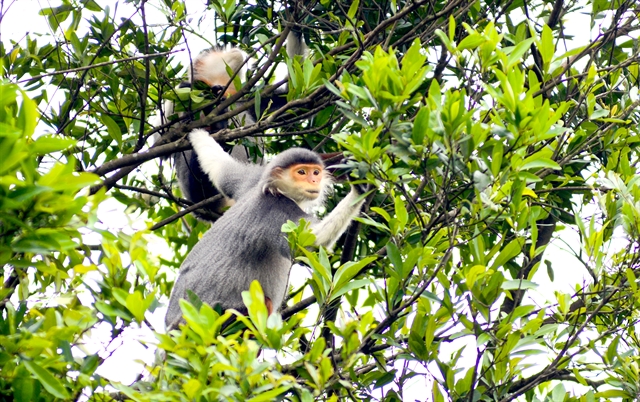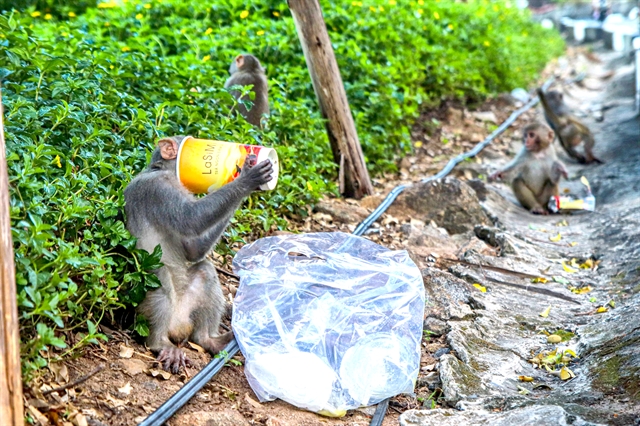 |
| The red-shanked douc langur species is part of a thriving conservation project on the Sơn Trà Peninsula. — VNA/VNS Photo Văn Dũng |
ĐÀ NẴNG — The monkeys at Sơn Trà Mountain, once an attractive feature to tourists, have now turned into a frightening ordeal. However, it is not the primates to blame, but rather, the human visitors.
The site, sometimes called Monkey Mountain in Đà Nẵng, is a place bustling with visitors on weekends. But a close kin of the humankind have also crowded the small peninsulas, the monkeys, who climbed down from the hills to seek food.
The primates are quite bold and tend to cling to tourists when offered food. Some even jump on people, grabbing food or any item they can, causing frustration among visitors.
Clutching a packet of biscuits tightly, eight-year-old T.K.Đ. from Hà Nội, who was visiting Đà Nẵng with his family, hurriedly followed his mother, nervously glancing around in fear of the monkeys. Seeing the large group of monkeys showing no fear and grabbing at the clothes of a visitor ahead, Hải Anh, T.K.Đ’s mother, quickly lifted her son up.
“At first, the kids were excited to see the monkeys and wanted to feed them, but these monkeys are aggressive. A teenage girl ahead of us, probably a high school student, had her phone yanked off her chest because she didn’t offer food and a monkey scratched her neck. My son got so scared he clung to me, asking to be carried,” Hải Anh recounted.
For a long time, the monkeys at Sơn Trà have grown accustomed to being fed by tourists. They increasingly gather at the Linh Ứng Pagoda (Bãi Bụt). When the food provided by visitors isn’t enough, hundreds of monkeys rummage through the garbage behind the pagoda for scraps.
Xuân, a volunteer at Linh Ứng Pagoda, noted that since early 2018, groups of monkeys, including red-bottomed macaques, baboons and rhesus monkeys, have been gathering at the pagoda’s rubbish site, disturbing tourists. There are incidents almost daily where monkeys attack visitors and on some days, there are up to four or five cases of people being attacked while feeding monkeys.
“Fortunately, they’ve only suffered minor cuts and bruises. Previously, the monkeys would react if tourists got too close or teased them, but now they come down frequently because they’re so used to being fed. If they don’t get food, they demand it and attack tourists. The pagoda had to enclose the rubbish bins to prevent the monkeys from making a mess, which could spoil the surroundings and spread diseases,” Xuân said.
But Sơn Trà isn’t the only place troubled by monkeys. In HCM City, Cần Giờ, once famous for its own Monkey Island, is now a source of fear for many visitors. Recalling an incident from four years ago, Hằng Nga from District 11, HCM City, still shudders at the cunning and boldness of the monkeys in Cần Giờ, as she and her ten-year-old son were attacked.
When the young boy held out a packet of snacks upon arriving at Monkey Island, a monkey lunged at him, grabbing the packet. Caught off guard, her son reflexively tried to pull it back, only to have his hand scratched by the monkey. Before they could recover, another monkey snatched the sunglasses hanging on her shirt collar. The more she chased it, the deeper it ran into the forest, eventually climbing a tall tree.
A security guard then advised Nga to buy a packet of food to exchange for the glasses. From high up, the monkey clung to the glasses, eyeing every move of its ‘victim.’ Only when the packet of food was laid out on a wooden plank, did the monkey drop the glasses into the mud below and rush down to grab the food.
“It was terrifying. I couldn’t believe the monkeys there were so cunning. Not only did they snatch things if not fed, but they also knew how to ‘blackmail’ for food. That was the first and last time I took my son to Monkey Island in Cần Giờ. Now, whenever he hears about visiting monkeys anywhere, he gets scared,” Hằng Nga said.
 |
| A monkey searching for food in rubbish bags. — Photo tuoitre.vn |
Not all fun and games
According to officials, the reason why benign monkeys are turning into ‘muggers’ is mainly due to the reckless behaviour of tourists who tease and feed them indiscriminately. Despite numerous warning signs against feeding monkeys, visitors continue to buy snacks from vendors, such as ice cream, coconuts, fruits and sweets, to lure the monkeys so that they can take photos or videos of them with their phones. Some even shook trees to scare the monkeys or provoke them for amusement.
These behaviours, in turn, have inadvertently made the monkeys more aggressive and familiar with human presence, accustomed to being fed and even developing a taste for human food.
Phan Thế Dũng, chief of the Forest Protection Division (Department of Agriculture and Rural Development, Đà Nẵng City), disclosed that monkeys now not only attack visitors or raid trash bins, but also enter shrines to take food, damage statues, and cause general havoc. Recently, the monkeys have moved into the surrounding areas of the Sơn Trà Peninsula, entering residential areas and even offices, to scavenge for food and attack people, leading to conflicts between humans and animals.
Residents of Thọ Quang Ward at the foot of Sơn Trà Peninsula have also complained about monkeys destroying their gardens and entering their homes in search of food. Monkeys no longer just search for food at shrines or temples, large groups now wait along tourist paths, such as near Bãi Bắc, Lê Văn Lương Road and Linh Ứng Pagoda, to beg. However, some tourists continue to bring food for the monkeys, gathering in large numbers and stopping vehicles on the road to view the monkeys, creating traffic hazards and affecting public order.
“The increased frequency of monkey attacks, causing injuries to tourists, is worrying. Additionally, there have been cases where monkeys climb power poles to get to the roads to beg for food, only to be electrocuted and fall to their death or suffer injuries. This is an alarming situation,” Dũng said.
Phan Minh Hải, deputy head of the Sơn Trà Peninsula and Đà Nẵng Beaches Tourism Management Board, emphasised that tourists feeding monkeys changes their instincts and foraging habits. Inappropriate food sources affect the health of these animals and close contact with them poses a risk of attacks on humans, threatening the environment and adversely affecting the ecosystem.
Not only do people directly feed monkeys, but many also leave food packets and litter along the road, leading monkeys to search through the trash, scattering rubbish along tourist routes and ruining the scenic beauty. Although staff from the Sơn Trà Peninsula and Đà Nẵng Beaches Tourism Management Board, along with the Sơn Trà-Ngũ Hành Sơn Forest Protection Subdivision, regularly patrol and remind tourists not to feed monkeys, they resume when the staff are not around.
“The management board regularly deploys staff or coordinates with the Sơn Trà-Ngũ Hành Sơn Forest Protection Subdivision to patrol and remind visitors along the route from the Lê Đức Thọ intersection to Bãi Bắc, the Linh Ứng Pagoda area, especially during peak hours and on weekends. However, the staff cannot cover the entire route or be on duty 24 hours per day and seven days per week to issue reminders. Therefore, self-awareness among the public is crucial,” said Hải. — VNS
- Reduce Hair Loss with PURA D’OR Gold Label Shampoo
- Castor Oil Has Made a “Huge” Difference With Hair and Brow Growth
- Excessive hair loss in men: Signs of illness that cannot be subjective
- Dịch Vụ SEO Website ở Los Angeles, CA: đưa trang web doanh nghiệp bạn lên top Google
- Nails Salon Sierra Madre
 VnExpress News The News Gateway of Vietnam
VnExpress News The News Gateway of Vietnam





